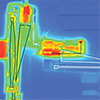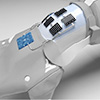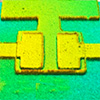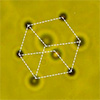Showing Spotlights 9 - 16 of 262 in category All (newest first):
 Innovative quantum neuroelectronic devices mimic key functions of brain synapses, demonstrating promise for reducing effects of age-related cognitive decline.
Innovative quantum neuroelectronic devices mimic key functions of brain synapses, demonstrating promise for reducing effects of age-related cognitive decline.
May 15th, 2024
 Researchers have created a novel memristive hardware framework that enables artificial intelligence systems to efficiently explain their decision-making process.
Researchers have created a novel memristive hardware framework that enables artificial intelligence systems to efficiently explain their decision-making process.
May 8th, 2024
 Researchers have developed an on-skin paintable waterproof biohydrogel for wearable bioelectronics, enabling high-fidelity monitoring of bioelectrical signals like ECG.
Researchers have developed an on-skin paintable waterproof biohydrogel for wearable bioelectronics, enabling high-fidelity monitoring of bioelectrical signals like ECG.
Apr 17th, 2024
 Researchers have developed innovative mechanical transistors that combine temperature-responsive materials and switchable structures, enabling complex logic operations and memory storage without electricity, opening up new possibilities for computing and environmental interaction.
Researchers have developed innovative mechanical transistors that combine temperature-responsive materials and switchable structures, enabling complex logic operations and memory storage without electricity, opening up new possibilities for computing and environmental interaction.
Mar 26th, 2024
 Researchers demonstrate highly deformable micro-supercapacitors using laser-patterned liquid metal electrodes, addressing key challenges in flexible energy storage.
Researchers demonstrate highly deformable micro-supercapacitors using laser-patterned liquid metal electrodes, addressing key challenges in flexible energy storage.
Mar 18th, 2024
 Exploring gate metal work function impact on nanoscale transistor performance for advanced electronics innovation and efficiency.
Exploring gate metal work function impact on nanoscale transistor performance for advanced electronics innovation and efficiency.
Mar 17th, 2024
 Researchers have developed a method for precisely controlling the 3D arrangement of microscopic particles using laser light and a phase-changing gel medium.
Researchers have developed a method for precisely controlling the 3D arrangement of microscopic particles using laser light and a phase-changing gel medium.
Mar 10th, 2024
 Revolutionary bioresorbable films extend life of implantable electronics, dissolving safely after use.
Revolutionary bioresorbable films extend life of implantable electronics, dissolving safely after use.
Mar 8th, 2024
 Innovative quantum neuroelectronic devices mimic key functions of brain synapses, demonstrating promise for reducing effects of age-related cognitive decline.
Innovative quantum neuroelectronic devices mimic key functions of brain synapses, demonstrating promise for reducing effects of age-related cognitive decline.
 Subscribe to our Nanotechnology Spotlight feed
Subscribe to our Nanotechnology Spotlight feed





